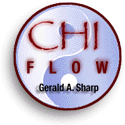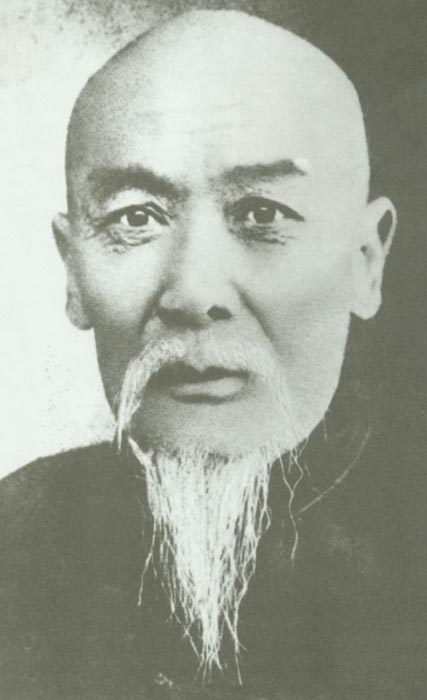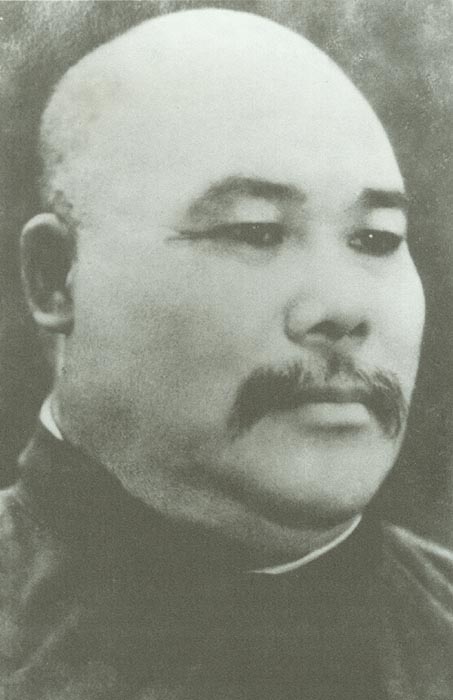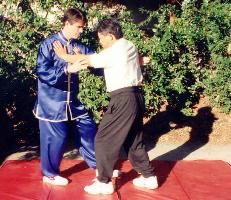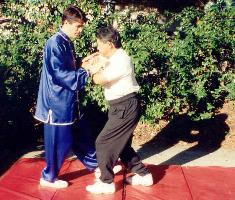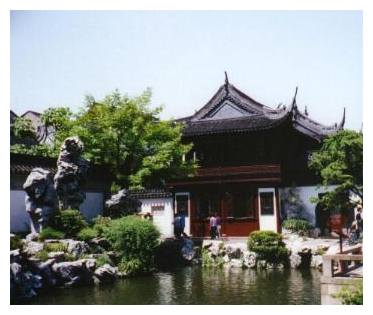Yang style Tai Chi (Part 3)
by Gerald A. SharpImages:
(Above) Application - Gerald A. Sharp Repulse Monkey App.
(Below) Drawing - Yang Chengfu - Repulse Monkey Form.
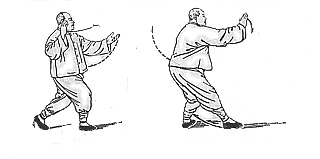
Yang Style is often recognized as the most popular of the five major styles of Taijiquan practiced in China today. Yang Style has gone through a host of changes and additions in its 150 year history. There is a vast range of variations and interpretations of the style.
Yang Style was created by Yang Luchuan and branched off of the Chen style teachings of Chen Changxing. The sons and grandsons of Yang Luchuan continued to change the Yang style. Wu style branched off from Yang style a bit later. The various teachers of Yang style have created many more branches. There has also been an emphasis only on T'ai Chi Ch'uan as a health exercise by some of these teachers.
|
1. Yang Shouhou
Yang Shouhou Yang Jianhou's sons were central figures in the development of the Yang style we see today. It should also be noted that Yang Shouhou was much older than his brother. They were taught, practiced and were teachers in quite different times. The relationship between the Yang and Wu families was still quite close. Wu Jian Qian's son trained with Yang Shouhou. Like Yang Banhou, Yang Shouhou did not teach many students. We know that Yang Shouhou practiced the Yang style Fast Set form that was the "brother" to the original Wu style form, the fast set. Yang Chengfu |
2.Yang Chengfu
Yang Chengfu I believe that the form Yang Chengfu practiced was not far off from the original more internal rendering of Taijiquan that Yang Luchan developed. I think that because of Chengfu's size, he was very often misinterpreted. For example, today we see people insisting on holding the hands up at certain heights and with specific alignments. I suspect that Chengfu based his alignment on his ability to expand with the least amount of force and effort. This allowed for him to develop a very strong Beng Jing (Ward Off Energy). However, those who emulated his postures, focused on the outside form and not on what he was doing to create those postures. In my opinion, it is deplorable to dismiss Yang Chengfu's form as a fat man's form, or a playboy's form. In my opinion, these kinds of statements dismiss the internal genius and simplicity of Yang Luchan's approach. Yang Chengfu, despite starting later in life than his other brothers, attempted to carry on the Yang family legacy. The biggest misconception of Yang Style is to dismiss the internal as nonsense and focus on the outward appearance and externally correct practice. It was easy to see how many people's practice became big at that time following the hefty Yang Chengfu. No matter what else you conclude about Yang Chengfu, he was not a lightweight. His nephew Fu Zhongwen shared a story about Yang Chengfu's approach of deriving chi from food: he made a point to drink a bowl of warm pig fat before practicing the Manquan, or Slow Set, 3 to 5 times every morning and again in the evening. This habit may have contributed to Yang Chengfu's relatively short life. |
|
3. Quan You and Wu Chian Chuan
Along side Yang Shou Hao and Yang Cheng Fu, Wu Chian Chuan popularized the Slow Set in 1911 at the Beijing Physical Culture Institute. Wu Quan You's early teachings of any Slow Set in Beijing appears to be carried on and interpreted by those who practice "Northern Wu" style. By comparison, it is easy to see in the "Northern Wu," the resemblance to Yang style with the back foot turned out and a more upright posture."Northern Wu" style appears to have carried forth Wu Quan You's earlier explorations into Yang Style. In many ways Northern Wu style may be closer to the original Yang Style of Yang Banhou and Yang Luchan than the Yang style that comes down to us through Yang Chengfu. Wu Chian Chuan style (A.K.A. Wu style) is sometimes called "Southern Wu" because Wu Chian Chuan moved to Shanghai in 1928. He established the Chian Chuan Taichichuan Association in 1935. Wu Chian Chuan focused more on refining the Slow Set as well as carrying forth his father's ideas of neutralization and compactness. Wu Chian Chuan's Slow Set developed from Quan You's fighting (fast) set, or Kuai Quan. That particular Wu style fast set likely developed from Yang's small frame (also called Applications frame). This Fast Set has a specific dynamic approach that can be difficult to reconcile with the Yoga-like aspects of Taijiquan. After exposure to this Wu style Fast Set, it becomes clear why a separate form is needed to teach the fundamental skills. Wu Chian Chuan also made further refinements. This explains Wu Chian Chuan Style's more compact stances and obvious emphasis on the small frame. These two surviving styles may also be closer to Yang's original style simply because they have passed through less hands. Both Wu style and Northern Wu style have kept a more direct line from Yang Style T'ai Chi Ch'uan practice before Yang Chengfu, even if they go by other names. |
4. Taking T'ai Chi Ch'uan Public
In 1911 Yang Shouhou, Yang Chengfu and Wu Chian Chuan taught Taijiquan at the Beijing Physical Cultural Association in Beijing. While Yang Shaohou and Wu Chian Chuan were likely the most skilled at the time, Yang Chengfu, like his father Yang Jianhou, was fun to be around. While some accounts paint Yang Chengfu as a playboy, he could not have accomplished what he did if he was not serious about Taijiquan, especially as he grew older. Yang Chengfu should not be dismissed as a serious teacher just because he had an affinity for enjoying life to its fullest. Despite stories to the contrary, Yang Chengfu was very skilled - especially after he began dedicating himself to the art when he was in his thirties. Yang Chengfu traveled to teach in Hong Kong and Guanzhou. Through his teaching and push hands demonstrations, Yang Chengfu carried forth Yang Luchan's legacy like no other family member before him. Due in part to the photographs of him in many of the form's postures as well as application photos, Chengfu's popularity soared. However, this popularity was not without a cost. Yang Chengfu effectively turned his family's business into a very public franchise. This approach takes the problems of following Yang style lineage and legitimacy to unprecedented levels of difficulty.
|
|
5. Major Changes to Teaching the Art
In 1930, Yang Chengfu's older brother, Yang Shouhou, died. Yang Chengfu visited Wu Chian Chuan in Shanghai and moved there. They developed a special comradery that few teachers of their level have ever shared. Yang Chengfu and Wu Jianquan met once a week to discuss principles and practice push hands - alone behind closed doors. Both Yang Chengfu and Wu Chian Chuan simplified the slow forms that they practiced. By simplified, I do not mean "watered down." Efficiency became the guiding principle. These are the key forms that teach the Yoga-like joint movements and fundamental practice of Taijiquan in the two styles that are most popular today. The relaxation-based Yoga-like structural aspects of Taijiquan are emphasized in the slow sets and these Yang and Wu style forms: criticism of the styles is usually associated with this emphasis in the way the styles are taught. The idea that any Taijiquan system is passed down from one generation to the next without any changes is simply absurd. At this point, it ought to be noted that neither of Yang Luchan's sons were completely dutiful followers. Both Yang Banhou and Yang Jianhou each had their own unique take on Taijiquan. Yang Banhou's teachings come down to us through the writings that are attributed to him. Yang Jianhou's teachings come down to us through his students and the generations of students that followed. It was Yang Jianhou's sons, Yang Shouhou and Yang Cheng Fu (Yang Zhengpu) that would have the greatest impact on changing and popularizing Yang Style. What's unfortunate is that due to Yang Style's over commercialization, the style experienced a massive fragmentation and misinterpretation. The efficiency of Yang style Taijiquan that was at the core of what Yang Chengfu promoted was ultimately picked up by only a handful of people.
|
6. Rapid Expansion of the Style
This period of rapid expansion of Yang style ended with Yang Chengfu's death at an early age. As if the genocide attempted by the Japanese during World War II wasn't enough, that dark period was followed by a civil war, a Chinese Nationalist exodus and a communist suppression of Taijiquan that have scrambled these issues of legitimacy for Yang style even more. Because of the fragmentation of many teachers and families, the Chinese government attempted to reorganize Taijiquan with the creation of the 24 Simplified, the 88, 48, and ultimately the 42 and a barrage of so called "traditional" competition forms. As if authentic learning in Taijiquan wasn't problematic enough, Taijiquan competitions have had a negative impact on Taijiquan, and because of Yang Style's popularity it has suffered the brunt of it. By the way, concerning competition, Taiwan as well as China, have created ridiculous free-for-all frenzies called Taiji tournaments where the rules and style are to be properly followed, and the principles of Taijiquan are to be forgotten. Taijiquan was never meant to be a competitive sport. Yang Chengfu's franchise approach to spreading Yang style did leave some good students to teach Yang style, but it also left a throng of confused practitioners as lineage holders. Yang Chengfu had sons, but the Yang family had no one prepared to be the family standard bearer when Yang Chengfu passed at the untimely age of 53. At least from what we see in the populous practice of Yang Style handed down from Yang Chengfu, it would appear that not all the changes Yang Chengfu made to his teaching were to promote martial efficiency: it is clear that over time Yang Chengfu dropped forms from his teaching curriculum. |
|
7. Yang Luchan's Legacy and Lineage
In the application of Yin and Yang in T'ai Chi Ch'uan practice: the idea of Yang represents force, while Yin represents softness. This particular point has a long and well documented history. It was central in the important points of practice as recorded by Wang Zong Yue and Li Yi Yu, and - arguably - it was de-emphasized later in the writings of Yang Banhou. It resurfaced in Wu Jianquan's treatise on Taijquan known as, "Ba Men, Wu Bu," or 8 Doors, 5 Steps. Wu Jianquan was not the only teacher who chose to emphasize this particular point, that softness overcomes hardness. Wu Yuxian and later Hao style practitioners have emphasized and maintained it as well. However, this premise is generally lacking in much of the present day Taiji culture where we see even so-called advanced practitioners and "Masters" using tricks and external blows that may include "chopping" or "ramming" to "conquer" their opponents. These sorts of approaches including the use of external Chin Na in Taijiquan application are not in accordance with the Classics that discuss using four ounces to overcome a thousand pounds of strength. In this context, it is then essential to advance in Taijiquan by focusing on stillness, softness, and flexibility, and to let go of excessive movement, hardness, and rigidity. |
8. More Branch Points
We have not yet come to the styles or sub-styles that are associated with any of Yang Chengfu's students. |

